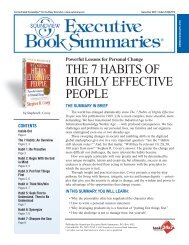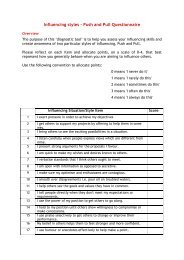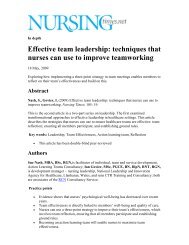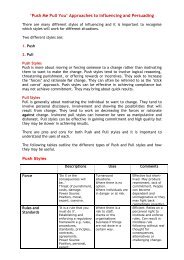Leadership: Time for a New Direction? - CTR training and consultancy
Leadership: Time for a New Direction? - CTR training and consultancy
Leadership: Time for a New Direction? - CTR training and consultancy
Create successful ePaper yourself
Turn your PDF publications into a flip-book with our unique Google optimized e-Paper software.
<strong>Leadership</strong><strong>Leadership</strong>: <strong>Time</strong> <strong>for</strong> a <strong>New</strong> <strong>Direction</strong>?Beverly Alimo-Metcalfe <strong>and</strong> John Alban-Metcalfe, <strong>Leadership</strong> Research &Development Ltd, Leeds, UKAbstract After reviewing the literature on leadership that culminated in what hasbeen described as the ‘<strong>New</strong> Paradigm’, this article discusses the research which hasled to the development of what might be regarded as a ‘<strong>New</strong> <strong>New</strong> Paradigm’ model.The research was based on a gender-inclusive <strong>and</strong> black <strong>and</strong> minority ethnicinclusivesample of over 3,500 managers <strong>and</strong> professionals, at different levels (chiefexecutives, top, senior <strong>and</strong> middle managers), working in the UK National HealthService <strong>and</strong> local government. The model that emerged, which led to the developmentof a diagnostic 360-degree feedback instrument, the Trans<strong>for</strong>mational <strong>Leadership</strong>Questionnaire, has been found to be sufficiently robust as to generalize to privatesector <strong>and</strong> other public sector organizations. Apart from having been inclusive at allstages of its development, the model is new in that it is based on a ‘nearby’ ratherthan ‘distant’ or ‘heroic’ approach to leadership, using a Grounded Theory methodology.It leads to an underst<strong>and</strong>ing of leadership that goes beyond trans<strong>for</strong>mationalmodels <strong>and</strong>, recognizing the significance of Greenleaf’s concept of ‘servant leadership’,focuses on the development of the individual, in an organizational context.Keywords gender-inclusive; nearby; paradigm; questionnaire; trans<strong>for</strong>mationalIntroductionThe history of leadership since the earliest <strong>for</strong>mal studies in the 1930s has been thesubject of recent reviews (<strong>for</strong> example, Alimo-Metcalfe & Alban-Metcalfe, 2002a;Northouse, 2001; Wright, 1996). Dissatisfaction with the relevance of the 1970s situationalmodels of leadership as, in essence, simply balancing concern <strong>for</strong> task <strong>and</strong>production with a concern <strong>for</strong> people, in the context of the tumultuous change thatfollowed the major recession of the 1970s, led some writers to regard them as bestdescribed as relating to ‘management’, as distinct from what we now regard as‘leadership’.What emerged out of the new approach to studying leadership – i.e. dealing withthe realities of constant change – came to be known as ‘<strong>New</strong> Paradigm’ models,which relate to concepts such as ‘charismatic leadership’ (Conger, 1989; House,1971), ‘visionary leadership’ (Sashkin, 1988), <strong>and</strong> ‘trans<strong>for</strong>mational leadership’(Bass, 1985). Whereas earlier ‘old paradigm’ models see leadership as a process, that(a) involves influencing others, (b) occurs within a group context, <strong>and</strong> (c) involvesCopyright © 2005 SAGE Publications (London, Thous<strong>and</strong> Oaks, CA <strong>and</strong> <strong>New</strong> Delhi)Vol 1(1): 51–71 DOI: 10.1177/1742715005049351 www.sagepublications.com
<strong>Leadership</strong>1(1) Articlesgoal attainment (Northouse, 2001), more recent definitions of leadership haveemphasized the role of leader as ‘defining organizational reality’ (Bryman, 1996).Other recent research interest has centred on relationships between leaders <strong>and</strong> followers,with some writers stressing the need to study ‘followership’. This has beenargued as important, not only because all leaders are also followers, but also becausemodern notions of leadership place considerable emphasis on the power <strong>and</strong> importanceof followers in ultimately legitimizing <strong>and</strong> enabling leadership (<strong>for</strong> example,De Pree, 1993; Lee, 1993). This last period saw the growth of attention to differencesbetween ‘leaders’ <strong>and</strong> ‘managers’ (cf. Kotter, 1990).A number of instruments have been devised to measure leadership, includingthose of Tichy <strong>and</strong> associates (Tichy & Devanna, 1986), Conger <strong>and</strong> Kanungo(Conger, 1989), <strong>and</strong>, most notably, Bass <strong>and</strong> Avolio (Bass 1985, 1998; Bass & Avolio,1990a, 1990b). The last of these is described as ‘trans<strong>for</strong>mational’ because of Bass’belief that an essential distinguishing feature of leaders is their ability to trans<strong>for</strong>mfollowers ‘to per<strong>for</strong>m beyond expectations’. In this, Bass subscribes to Burns’s(1978) belief that, by engaging the followers’ higher needs, trans<strong>for</strong>mational politiciansmove followers beyond their self-interest to work <strong>for</strong> the greater good, <strong>and</strong>that, as they do so, they become self-actualizing, <strong>and</strong> become leaders themselves.This, Burns <strong>and</strong> Bass contrast with transactional leadership, which is epitomized bytrading promises <strong>for</strong> votes.Currently, Bass <strong>and</strong> Avolio see transactional leadership as comprising threedimensions: (a) management-by-exception passive, (b) management-by-exceptionactive, <strong>and</strong> (c) contingent reward. On the other h<strong>and</strong>, trans<strong>for</strong>mational leadership –seen as the most active <strong>and</strong> effective style – comprises: (a) attributed idealized influence(attributed charisma), (b) behavioural idealized influence (behaviouralcharisma), (c) inspirational motivation, (d) intellectual stimulation, <strong>and</strong> (e) individualizedconsideration.<strong>Leadership</strong> <strong>and</strong> distanceA seminal study by Shamir (1995) provided evidence of differences in the way inwhich ‘distant’ leaders are perceived, in contrast to perceptions of ‘close’ or ‘nearby’leaders. Exploration of the implications of this distinction has been the focus ofstudies of the relationship between leader behaviour <strong>and</strong> leader-subordinate distance(see Antonakis & Atwater, 2002, <strong>for</strong> a review).We became increasingly concerned with the almost unquestioning acceptance ofa body of ‘received wisdom’ on the nature of leadership, which pervaded the mostcommonly read texts in both the business <strong>and</strong> the academic literature. This is not tosay that there was no variety in the models being offered, but of the most commonlyaccepted models, they were virtually all based on US studies. There were otherreasons <strong>for</strong> discontent, which are explained below.The dominance of US modelsWhile recognizing <strong>and</strong> valuing the ground-breaking research emanating from theUS, we were interested in whether dimensions of trans<strong>for</strong>mational leadership, whichhave emerged from North American studies were similar to those found in UK52
<strong>Leadership</strong><strong>Time</strong> <strong>for</strong> a <strong>New</strong> <strong>Direction</strong> Alimo-Metcalfe & Alban-Metcalfeorganizations, particularly those in the public sector. The issue of the generalizabilityof US approaches to leadership has also been raised by other researchers,including North American writers, (e.g. Adler, 1983a, b; Erez, 1990; Hunt &Peterson, 1997; Smith & Bond, 1993; Smith et al., 1989; Smith & Peterson, 1988;Tri<strong>and</strong>is, 1990, 1993).Also, US research on the new trans<strong>for</strong>mational paradigm has been based, in themain, on observations of top managers in organizations, rather than middle <strong>and</strong> lowerlevel managers (Bryman, 1996). This contrasts with earlier leadership research, suchas the Ohio State studies of the 1950s <strong>and</strong> 1960s, which focused on the styles of lowerlevel managers <strong>and</strong> supervisors. It is, perhaps, also worthy of comment that sinceleadership, particularly ‘new paradigm leadership’, is seen primarily as a social influenceprocess (e.g. Bass, 1985, 1990a, b; Bass & Avolio, 1994; Bryman, 1992, 1996;Hogan et al., 1994; Parry, 1998; Yukl, 1994), some of the new leadership models havebeen based on data collected by researchers interviewing chief executives <strong>and</strong> seniormanagers, rather than data collected directly from those they are responsible <strong>for</strong>managing.Studies based on researchers’ views can, of course, provide valuable insights intoleadership. However, it is important to distinguish between (1) the models of leadershipwhich have evolved from data collected as a result of researchers interviewingtop managers, (2) studies based on eliciting the perceptions of managers, at all levels,construing managers at the top level (i.e. ‘distant’ leadership), <strong>and</strong> (3) studies basedon eliciting the perceptions of managers, at all levels, construing their immediate linemanager/supervisor (i.e. ‘close’ or ‘nearby’ leadership). The distinction between‘distant’ <strong>and</strong> ‘close/nearby’ leadership is particularly important. If one describes aparticular model of leadership without making it perfectly clear what is the exactnature of the focus, <strong>and</strong> the method of data collection, there is a serious danger ofconfounding our underst<strong>and</strong>ing of the phenomenon. This view is consonant withthose expressed by Antonakis <strong>and</strong> Atwater (2002), cited above.A desire to be inclusiveGenderIn spite of over 60 years of leadership research, it would seem that no serious attempthas been made, in any of the mainstream research into the nature of leadership, toensure that samples of subjects, from whom notions of leadership were gathered inorder to develop a model, include a significant, if not fairly equal proportion, offemales to males. Since the early 1990s, however, a number of studies have foundgender differences with respect to aspects of leadership style preference. Theseinclude that:■■■women are more likely to construe leadership in trans<strong>for</strong>mational terms, menin transactional (e.g. Alban-Metcalfe, 1995; Sparrow & Rigg, 1993);woman are more likely than men to describe the style of leadership theyadopt as being trans<strong>for</strong>mational, with men more likely to describe theirleadership in transactional terms (Rosener, 1990); <strong>and</strong>women are significantly more likely to be described by their direct reports asadopting a trans<strong>for</strong>mational style (irrespective of the sex of their direct53
<strong>Leadership</strong>1(1) Articlesreport), (Alimo-Metcalfe & Alban-Metcalfe, 2003a), with men more likely tobe described as adopting a laissez-faire, or management-by-exception style(e.g. Bass, 1998; Bass & Avolio, 1990a, b, 1994; Bass et al., 1996; Druskat,1994).Culture <strong>and</strong> leadershipRecent attention has focused on the extent to which notions of leadership (both trans<strong>for</strong>mational<strong>and</strong> transactional) generalize from one culture to another. Here, both‘emic’ or idiographic, <strong>and</strong> ‘etic’ or nomothetic approaches (Berry, 1969; Den Hartoget al., 1999) have provided evidence of leadership behaviours that are cross-cultural,<strong>and</strong> those that are culturally specific. The extensive, international investigation of thegeneralizability of concepts of leadership among a total of 62 cultures (Den Hartoget al., 1999) led to the identification of 21 lower order <strong>and</strong> 6 higher order concepts.Using a combination of emic <strong>and</strong> etic approaches, evidence was presented to supporttheir hypothesis of the generalizability of specific aspects of charismatic/trans<strong>for</strong>mationalleadership.A recent study by Booysen (1999), in which attributes of leadership were elicitedfrom black <strong>and</strong> white South African bank managers, has pointed to significant differencesin what is seen as appropriate leadership behaviour. Un<strong>for</strong>tunately, studies ofthis kind, which gather data from individuals from different ethnic <strong>and</strong> culturalgroups, are still comparatively rare.The dangers of charismatic leadershipThere is a distinct shift in thinking, away from extolling the charismatic-inspirational,or as is often described, ‘heroic’ models of leadership, <strong>and</strong> even a growing antipathytowards such models. Various reasons are behind this movement, including a concern<strong>for</strong> the potentially lethal ‘dark side’ of charismatic leadership. Conger (1998),Mintzberg (1999), <strong>and</strong> Hogan <strong>and</strong> colleagues (Hogan et al., 1990), point to thedamage that can be inflicted by narcissistic, self-serving leaders – particularly thosein the most senior positions, who may not only attribute the organization’s successalmost exclusively to their own contributions, but perhaps more lethally, ignore orpunish any <strong>for</strong>m of criticism or advice offered to them. Mintzberg (1999) admonishesthe business magazines <strong>for</strong> selling the cult of ‘Heroes of American management’,who are glorified <strong>for</strong> apparently single-h<strong>and</strong>edly ‘saving’ or ‘turning around’global companies, only <strong>for</strong> those companies <strong>and</strong> their CEOs to be publicly chastizedwhen infatuation was followed by dramatic failure. In the wake of the recentcorporate corruption cases, such as the Enron, Amcom <strong>and</strong> WorldCom sc<strong>and</strong>als,catastrophes have been attributed, at least in part, to the virtually ‘delusional’ <strong>and</strong>/oruntempered arrogance of their top executives.Another line of criticism of the heroic theme has been provided by writers suchas Gronn (2002), <strong>and</strong> Mintzberg (1999), who strongly challenge the concept ofleadership residing in one individual, <strong>and</strong> contributing uniquely to organizationalsuccess, asserting that leadership, <strong>and</strong> importantly, learning from experience, isdistributed throughout the organization. Stacey (1999) articulates the dangers ofperpetuating the notion of leadership relating to ‘special powers’ of certain individuals:54
<strong>Leadership</strong><strong>Time</strong> <strong>for</strong> a <strong>New</strong> <strong>Direction</strong> Alimo-Metcalfe & Alban-Metcalfethe myth that organizations have to rely on one or two unusually giftedindividuals to decide what to do, while the rest enthusiastically follow . . .[encourages] cultures of dependence <strong>and</strong> con<strong>for</strong>mity that actually obstruct thequestioning <strong>and</strong> complex learning which encourages innovative action.Unsurprisingly, the business literature is placing far more attention on ethics,morality, transparency, <strong>and</strong> corporate governance. Likewise the leadership literatureis seeing a growth in articles on ethical <strong>and</strong> ‘authentic’ leadership (e.g. Ciulla, 2004;May et al., 2003).Finally, it is important to note that the models referred to above were developedaround 20 years ago. Given the technological, economic, social, <strong>and</strong> political changesover this time span, it may well be time <strong>for</strong> a re-evaluation of our underst<strong>and</strong>ing ofwhat is leadership, <strong>and</strong> its meaning in the 21st century.The present studyCognisant of the above factors (particularly in relation to leaders, distance, gender<strong>and</strong> ethnicity, <strong>and</strong> level in the organization), we set out, using a Grounded Theoryapproach (Parry, 1998), to elicit the constructs in a gender-inclusive <strong>and</strong> black <strong>and</strong>minority ethnic (BME)-inclusive study of trans<strong>for</strong>mational leadership. We involvedmanagers across various levels – from middle to top – using repertory grid technique.We elicited constructs from equal numbers of male <strong>and</strong> female managers <strong>and</strong> professionalsat all levels (Chief Executive; top, senior <strong>and</strong> middle managers) in arepresentative sample of NHS Trusts <strong>and</strong> local government organizations in Engl<strong>and</strong><strong>and</strong> Wales.The 2000-plus constructs that emerged, from both the NHS <strong>and</strong> local government,were combined, <strong>and</strong> content analysed by two psychologists working independentlyof each other. Forty-eight groupings emerged, each group comprising amix of constructs from both types of organization. A small group of constructsrelating to dealing with politicians were unique to local government, <strong>and</strong> clearlyreflected the particular context of these managers’ roles. The common constructs<strong>for</strong>med the basis of a pilot questionnaire, which was constructed, following the principlesof Facet Theory (Donald, 1995). Packs of the pilot questionnaire were distributedto a stratified sample of NHS organizations, which were asked to distributethem along guidelines suggested by the researchers, reflecting roughly, the proportionof managers <strong>and</strong> professional in the organization, working at middle to toplevels. The number of usable responses from the NHS organizations was n = 2013,approximately half of whom were female, <strong>and</strong> included over 10 percent of individualsfrom BME backgrounds. A separate, parallel study was undertaken amongn = 1464 managers <strong>and</strong> professionals working in local government, which hasalready been reported (Alban-Metcalfe & Alimo-Metcalfe, 2000; Alimo-Metcalfe& Alban-Metcalfe, 2001).ResultsResponses from n = 2013 were divided into two groups: Group A comprisedmanagers at Chief Executive, top <strong>and</strong> senior management levels; Group B comprised55
<strong>Leadership</strong>1(1) Articlesmiddle managers; there were approximately equal numbers in each group. Theresponses from Group A were subject to principal components analysis, includingrotation to an oblimin solution. Interestingly, factor 1 accounted <strong>for</strong> over 44 percentof the total variance. In order to test <strong>for</strong> robustness, the six-factor solution thatemerged was imposed on the Group B data, <strong>and</strong> congruence between the solutions(Gorsuch, 1983) was found to hold true (range 0.90–0.97). The data <strong>for</strong> Groups A<strong>and</strong> B were combined, <strong>and</strong> congruence between the oblimin <strong>and</strong> the varimax solutionranged from 0.90–0.93.Finally, in order to test the generalizability of the solution to managers <strong>and</strong> professionalsfrom a different organization, the NHS solution was imposed on the stratifiedsample of n = 1464 local government managers <strong>and</strong> professionals. Thesix-factor solution held true (range 0.90–0.94), except that the number of items infactor 4 was reduced from 13 to 4.The six emergent factors were interpreted as:(1) Valuing Individuals (Genuine concern <strong>for</strong> others’ well being <strong>and</strong>development);(2) Networking <strong>and</strong> Achieving (Inspirational communicator, networker <strong>and</strong>achiever);(3) Enabling (Empowers, delegates, develops potential);(4) Acting with Integrity (Integrity, consistency, honest <strong>and</strong> open);(5) Being Accessible (Accessible, approachable, in-touch);(6) Being Decisive (Decisive, risk-taking).Cronbach alpha coefficients were calculated <strong>for</strong> each of the six factors <strong>and</strong> found toexceed α = 0.7 (range α = 0.83–0.96). In order to ensure uni-dimensionality (Cortina,1993), inter-item correlation coefficients were also calculated, <strong>and</strong> found to exceedr = 0.3 (range r = 0.34–0.73).The validity was tested against five criterion variables (four derived from Bass[1985], plus reduces job-related stress). Correlation coefficients ranged from r =0.47–0.80, p < 0.01 in each case, suggesting a high level of convergent validity. Thereis also evidence of a high level of discriminant validity, using Wilk’s lambda, <strong>for</strong>whole groups, <strong>and</strong> <strong>for</strong> subgroups divided by level, sex, <strong>and</strong> level <strong>and</strong> sex. Suchfindings are consonant with evidence of the effect of situational factors (Alban-Metcalfe <strong>and</strong> Alimo-Metcalfe, 2000) <strong>and</strong> distance (Antonakis & Atwater, 2002).The <strong>for</strong>egoing analyses led to the development of the Research Version of theTrans<strong>for</strong>mational <strong>Leadership</strong> Questionnaire (TLQ).In order to capture the richness of the constructs that emerged, <strong>and</strong> <strong>for</strong> the purposeof developing a Training Version of the TLQ, two further principal componentsanalyses were per<strong>for</strong>med on the remaining items. A further eight factors emerged. Inorder to establish the robustness <strong>and</strong> generalizability of each of these new solutions,the same statistical techniques were applied as previously, though it is explicitlyrecognized that each of these further factors cannot be regarded as statistically significantlyseparate since they share variance in common with the first six factors. Thesefactors are described in Figure 1, <strong>and</strong> their construct validity has been discussed elsewhere(Alban-Metcalfe & Alimo-Metcalfe, 2003a).56
<strong>Leadership</strong><strong>Time</strong> <strong>for</strong> a <strong>New</strong> <strong>Direction</strong> Alimo-Metcalfe & Alban-MetcalfeContent validityFirstly, the methodology – based as it was on a Grounded Theory approach – wasdesigned to gain in<strong>for</strong>mation about the perceptions of individuals who are perceivedto possess leadership characteristics, in that they have a particularly powerful effecton others’ motivation, self-confidence, self-efficacy, or per<strong>for</strong>mance. To interpretsuch perceptions as reflecting trans<strong>for</strong>mational leadership is wholly consonant withthe Third Corollary of trans<strong>for</strong>mational leadership (Bass & Avolio, 1993), whichstates that ‘whatever the country, when people think about leadership, their prototypes<strong>and</strong> ideals are trans<strong>for</strong>mational’ (Bass, 1997: 135). Secondly, in writing theindividual items, great care was taken, not only to ensure that – following the principlesof Facet Theory (Donald, 1995) – the phraseology was in identical <strong>for</strong>mat, butalso that they reflected accurately the constructs elicited. Furthermore, following thestrictures of Hunt (1996) <strong>and</strong> others, only items which referred to the behaviour ofthe leader, as distinct from the effect that s/he might have on others, were includedin the analyses. For these reasons, it can be argued that the TLQ can be regarded asdemonstrating content validity as a measure of trans<strong>for</strong>mational leadership.Construct validityThe construct validity of the instrument was assessed by considering ways in whicheach of the factors measures aspects of trans<strong>for</strong>mational leadership literatureidentified in the literature.Factor 1 – Valuing individuals (genuine concern <strong>for</strong> others’ well-being <strong>and</strong>development)This factor relates to Burns’s (1978) notion of the need <strong>for</strong> leaders to engage thewhole person of their followers, reflected in sensitivity to their needs <strong>and</strong> feelings,active support of their development, <strong>and</strong> communicating positive expectations. It canalso be seen to share considerable similarity with Bass’s notion of ‘Individualizedconsideration’, which emerged as third, of three trans<strong>for</strong>mational factors, in the MLQ(Bass & Avolio, 1994), with the sensitivity to followers’ needs aspect of the first stageof Conger’s model (Conger, 1989), <strong>and</strong> with the respectful leadership dimension ofSashkin’s Visionary <strong>Leadership</strong> Framework (Sashkin, 1988).It is, however, important also to note differences between the UK <strong>and</strong> USapproaches. One difference is that the UK dimension is more complex in terms ofthe specificity <strong>and</strong> range of items which load on this factor; this was also found ina study of trans<strong>for</strong>mational leadership in local government (Alimo-Metcalfe &Alban-Metcalfe, 2001). The second is that it includes items relating to valuing <strong>and</strong>developing the team, as well as the individual. The third, <strong>and</strong> most important, is that,unlike most US models where vision <strong>and</strong> charisma dominate, this factor is unequivocallythe most important aspect of trans<strong>for</strong>mational leadership in the UK sample,explaining more variance than all the remaining factors together. Whether thismerely reflects the methodology adopted – i.e. because it is based on close/nearbyperceptions of leadership, or whether this was due to the fact that there was a substantialproportion of females in the sample at all stages, or whether it reflectscultural differences, cannot be determined at this stage. Whatever the reason, it57
<strong>Leadership</strong>1(1) Articlesprovides an important aspect of difference. Another obvious reason might be thatthe context was the public sector, where it is often assumed more ‘softer’ skills arerequired. This remained unexplored, until we undertook a similar, but smaller studyof leadership in the private sector (Alimo-Metcalfe & Alban-Metcalfe, 2002b),where we found almost identical constructs of leadership, <strong>and</strong> a similar emphasison this first factor.Factor 2 – Networking <strong>and</strong> achieving (inspirational communicator, networker<strong>and</strong> achiever)Factor 2 focuses attention on the way in which the manager is able to inspire bothcolleagues <strong>and</strong> members of the external community. In so doing, it highlights theability to communicate a vision, coupled with the political <strong>and</strong> social skills necessaryto bring about change, including through networking. The communicating <strong>and</strong>implementing a vision aspects of this factor link directly to stage two of the Conger(1989) framework – communicating the vision; to vision <strong>and</strong> articulation, identifiedby Tichy <strong>and</strong> Devanna (1986); to House’s (1971) notions of a charismatic leader; toSashkin’s visionary leadership (Sashkin, 1988; Sashkin & Burke, 1990; Sashkin &Fulmer, 1988); <strong>and</strong> to communicating the vision personally (Bennis & Nanus,1985).The ‘networker’ aspect of this factor merits comment in the light of Kotter’s(1982) conceptualization of vision <strong>and</strong> charisma, in terms of ‘agenda setting’ <strong>and</strong>‘networking’. For Kotter, networking involves establishing as wide a set of contactsas possible, <strong>and</strong> using interpersonal skills to influence these <strong>and</strong> other people, <strong>and</strong>events. Hunt (1996) commented that Kotter’s proposal serves to reduce the‘mystique’ surrounding charisma, <strong>and</strong> noted that Luthans <strong>and</strong> co-workers (Luthans& Lockwood, 1984) <strong>and</strong> Yukl (1999) incorporated the networking aspects of trans<strong>for</strong>mationalleadership into their typologies, though, as Hunt (1996: 197) states, madeno claim that they tapped ‘charisma’. Kotter (1982) also placed emphasis on ‘inspiration’<strong>and</strong> ‘motivation’ as central components of leadership (as distinct frommanagement), <strong>and</strong> argued <strong>for</strong> ‘thick networks of relationships’ (cited by Hunt, 1996:198). Hunt also went on to note that ‘Kotter’s treatment of leadership is similar insome ways to Conger’s treatment of the vision of noncharismatic leaders’ (Hunt,1996). In its composition, this factor corresponds to factors identified in the localgovernment research (Alimo-Metcalfe & Alban-Metcalfe, 2001), but the differencecan be attributed to differences in the content of the instruments used.Factor 2 also shares some characteristics in common with the MLQ, in particularwith the ‘Inspirational-charismatic’ dimension. It has, however, a crucially importantadditional aspect, which is ‘sensitivity to the agenda of different keyplayers/interest groups, such that they all feel they are being served by the vision’.Thus, while there is some similarity between this UK factor <strong>and</strong> US models citedabove, the essential difference is that the UK dimension has a much stronger senseof working with ‘constituents’/stakeholders, of underst<strong>and</strong>ing their agenda, <strong>and</strong> ofcreating a shared vision. Such ‘political’ sensitivity to the agenda of a diverse rangeof internal <strong>and</strong> external stakeholders is of considerable importance in the Britishpublic sector, where increased cross-boundary <strong>and</strong> inter-agency working isdem<strong>and</strong>ed by national government. It is not surprising, there<strong>for</strong>e, that this factorreflects the ef<strong>for</strong>ts, conviction, <strong>and</strong> success of those leaders who can unite all parties58
<strong>Leadership</strong><strong>Time</strong> <strong>for</strong> a <strong>New</strong> <strong>Direction</strong> Alimo-Metcalfe & Alban-Metcalfein working towards a shared vision. However, in a more recent study we have undertakenin the private sector (Alimo-Metcalfe & Alban-Metcalfe, 2003b), this aspectof underst<strong>and</strong>ing the needs <strong>and</strong> agenda of a range of internal <strong>and</strong> external stakeholdersalso emerged.Factor 3 – Enabling (empowers, delegates, develops potential)The third factor to emerge is concerned with the extent to which empowerment isachieved as a result of the manager trusting her/his staff to take decisions, <strong>and</strong> encouragingthem to take on responsibility, to think of new approaches to problems, <strong>and</strong> tothink strategically.This aspect of trans<strong>for</strong>mational leadership can be interpreted in the context of thework of Sashkin <strong>and</strong> co-workers. As Hunt (1996: 195) noted in relation to their work,‘Essentially, in the visionary leadership framework, strategic leaders believe they canhave a major impact on the organization by empowering organization members torealize the leader’s long-term organizational vision’. Conger (1989) places empowermentclearly in the fourth stage of his model, as integral to demonstrating ways ofachieving the vision. Although not a dimension in its own right in the MLQ, it constitutesan element of ‘Individualized consideration’.The theme of empowerment has been ubiquitous throughout the leadershipmodels emerging over the last few decades, but the term can be applied to verydifferent power relations between managers <strong>and</strong> their direct reports (Alban-Metcalfe,1995). It can be, <strong>and</strong> arguably is, most often applied to a ‘leader’ ‘granting’ her/hisdirect report an opportunity to exercise discretion, but not so as to reduce the powerof the manager. That is, a ‘grace <strong>and</strong> favour’ power relationship. Alternatively, it canbe the act of a manager to truly enable a direct report to enact their discretion, whichas a result, to some extent, disempowers the manager. The tenor of the items in theTLQ appear to reflect the latter example far more closely.Once again, a corresponding factor emerged in the local government research(Alimo-Metcalfe, 2000).Factor 4 – Acting with integrity (integrity, consistency, honest <strong>and</strong> open)In this factor, which also emerged in the local government data, the emphasis is uponintegrity, <strong>and</strong> openness <strong>and</strong> honesty in dealings with others, <strong>and</strong> on being consistent<strong>and</strong> equitable in the way in which the manager treats different members of staff. Therelevance of this factor is encapsulated in the observation of Burns (1978: 20), thattrans<strong>for</strong>mational leadership is a process whereby ‘leaders <strong>and</strong> followers raise oneanother to higher levels of morality <strong>and</strong> motivation’. The integrity of the leader isclearly prerequisite to the realization of the process.All the major models of trans<strong>for</strong>mational <strong>and</strong> charismatic leadership refer to theimportance of the integrity of the leader. Bass, in particular, has pointed to the criticalimportance of integrity in distinguishing the authentic from ‘pseudotrans<strong>for</strong>mational’leaders (e.g. Bass, 1998; Bass & Steidlmeier, 1999). In Bass’s model of trans<strong>for</strong>mationalleadership, integrity resides most explicitly in the ‘Inspirationalcharismatic’dimension, but Bass is at pains to stress the pervasive nature of thisquality, stating, ‘If such trans<strong>for</strong>mational leadership is authentic [Bass’s emphasis],it is characterised by high moral <strong>and</strong> ethical st<strong>and</strong>ards in each of the dimensions’(Bass & Steidlmeier, 1999: 2).59
<strong>Leadership</strong>1(1) ArticlesIt is worth noting, however, that there are three differences between our study <strong>and</strong>the representation of integrity in the MLQ. The first is that, in the current study,‘integrity’ <strong>for</strong>med a separate factor in its own right, <strong>and</strong> was represented in far greaterdetail <strong>and</strong> complexity, on a scale with high internal reliability. In contrast, integrityis a relatively small, albeit important, element of a more general ‘Inspirational-charismatic’dimension of the MLQ. The second point is that the Integrity factor emergingfrom the UK data is combined with a sense of humility <strong>and</strong> vulnerability, e.g. ‘isprepared to admit when s/he is wrong or has made a mistake’; <strong>and</strong> emphasizesaltruism, e.g. ‘regards the good of the organization as more important than satisfyinghis/her own personal ambition’. The third is that this scale of the TLQ includesitems relating to being open to criticism from staff, <strong>and</strong> being prepared to modifyone’s views after listening to others’ ideas <strong>and</strong> views, <strong>and</strong> not being threatened bythe effectiveness of others.Whether the distinction between the US <strong>and</strong> British connotations of ‘integrity’ asa component of trans<strong>for</strong>mational leadership is due to cultural differences, or to theparticular methodology adopted, including, importantly, the views of those managedby the ‘leaders’, is unclear. Again, one might reasonably have hypothesized that thisleadership characteristic may be a particularly important, if not the core representation,of the UK public sector service ethic, <strong>and</strong> thus reflect an important contextualleadership variable. However, the private sector version of the TLQ also includes theaspect of preparedness to admit one’s mistakes, <strong>and</strong> being willing to admit that, attimes, the manager does not know what to do (Alimo-Metcalfe & Alban-Metcalfe,2000). Also, it is worth noting that the US leadership literature has relatively recentlystarted to use the term ‘humble’ in the same context as effective leadership, possibly– at least in part – due to the prominence of Jim Collins’s study of successful companies,Good to Great (2001), in which he described the strongest theme characterizingthe approach of the highly effective leaders as combining personal humilitywith intense professional will. Another possible influence might be because of thenumerous cases of corporate corruption that have received extensive media coverage,<strong>and</strong> the resultant ‘de-bunking’ of the mythology of the omniscience of those occupyingthe highest echelons of mega-corporations.In his critique of the ‘charismatic literature’, Yukl (1999) makes the distinctionbetween personal identification with a ‘charismatic leader’, which ‘creates loyal,obedient followers, but may inhibit them from providing feedback to the leader orshowing initiative’, <strong>and</strong> a different kind of relationship with the leader, in which ‘theprimary influence process is internalisation, <strong>and</strong> task objectives are linked to afollower’s core values <strong>and</strong> self-identity when followers come to see their work rolesas an important part of their self-identity’ (pp. 294–5).Factor 5 – Being accessible (accessible, approachable, in-touch)This factor comprises items that reflect accessibility to the manager of direct reports<strong>and</strong> other colleagues, ‘despite being very busy’ (TLQ), <strong>and</strong> the adoption of an interpersonalstyle that is neither threatening, nor <strong>for</strong>mal. It also reflects the trans<strong>for</strong>mationalmanager’s sensitivity to the impact of her/his actions on staff. This dimensioncan be seen as one of the requirements <strong>for</strong> the kind of behaviours measured by theMLQ factor, ‘Individualized consideration’, <strong>and</strong> also ‘Intellectual stimulation’, thefocus of attention of which includes enabling followers to look at problems from60
<strong>Leadership</strong><strong>Time</strong> <strong>for</strong> a <strong>New</strong> <strong>Direction</strong> Alimo-Metcalfe & Alban-Metcalfemany angles. The TLQ factor can be seen to be relevant to these two dimensions inthat, unless the direct reports are able to communicate their solutions to their boss,their labours are in vain. However, Factor 5 goes beyond this, since its focus is onday-to-day accessibility <strong>and</strong> approachability, <strong>and</strong> also on the manager’s commitment‘. . . to developing their own competence as a leader’.Accessibility <strong>and</strong> approachability do not appear to be addressed explicitly, assuch, by the MLQ. However, sensitivity can be linked directly to two of the Tichy<strong>and</strong> Devanna (1986) dimensions – ‘environmental sensitivity’, <strong>and</strong> particularly,‘sensitivity to members’ needs’ – <strong>and</strong> to Conger’s model.Factor 6 – Being decisive (decisive, risk-taking)This factor, <strong>and</strong> a corresponding factor in the local government data, can be seen tomeasure a preparedness to take tough decisions when required, determination toachieve goals, <strong>and</strong> confidence in oneself. It can, thus, be interpreted as reflectingcertain personal characteristics, perceived among UK leaders who are regarded astrans<strong>for</strong>mational, in two different public sectors. Hunt (1996) noted, in relation to thework of House (1971), ‘Charismatic leaders are differentiated by dominance, selfconfidence,need to influence, <strong>and</strong> strong conviction in the moral rightness of theirbeliefs’ (p. 187). The behaviours that comprise Factor 6 reflect a different tenor fromthe US model. The difference in tenor may be due to cultural factors, with Britishmanagers presenting a more ‘low key’ manifestation of the construct, or it may reflecta different construct of leadership.What is evident, then, is that each of the factors that emerged from the analysescan be seen to reflect a different aspect of trans<strong>for</strong>mational leadership. Furthermore,the whole tenor of the instrument, with its emphasis on ‘close’/‘nearby’ leaders,reveals a predominant emphasis on what the leader can do <strong>for</strong> the follower, whichis akin to Greenleaf’s notion of ‘leader as servant’ (Greenleaf, 1970, 1996). This willbe referred to again in a later section.Convergent validityIn order to examine the convergent validity of the instrument, five items (criterionvariables) were included within the Pilot Instrument, which were designed tomeasure the perceived effect of the manager on the individual’s ‘Achievement’, ‘Jobsatisfaction’, ‘Motivation’, ‘Satisfaction with leadership style’, <strong>and</strong> ‘Stress’. The firstfour were chosen since they had been used to establish the convergent validity ofanother, comparable instrument, the MLQ (e.g. Bass, 1985; Bass & Avolio, 1990a,b). The fifth was chosen <strong>for</strong> two major reasons: (1) the increasing concern in the NHSwith high levels of stress among a range of staff, <strong>and</strong> the prominence of a recent studysponsored by the Department of Health, which concluded that:(i)i The mental health of the work<strong>for</strong>ce in NHS Trusts (hospitals) issubstantially poorer than that of employees in general, outside the NHS,(ii) The overall percentage of probably psychiatric cases (i.e. scoring such highlevels of stress on the GHQ-12 to be deemed probable cases of minorpsychiatric disorder) among staff in NHS Trusts is 26.8. (Borrill et al.,1996)61
<strong>Leadership</strong>1(1) ArticlesConclusions<strong>and</strong> (2) in the light of substantial evidence that leader behaviour, such as allowinggreater autonomy <strong>and</strong> empowerment, <strong>and</strong> offering greater social support, moderatesthe deleterious effects of per<strong>for</strong>mance pressure (e.g. Fox et al., 1993; Offerman &Hellman, 1996; Quick et al., 1992; Sauter et al., 1990). There is also evidence, fromwithin the NHS, that influence over decisions as to how one carries out one’s job isnegatively correlated with perceived job-related stress (Borrill et al., 1996; Borrill etal., 1998).In view of the possibility of ‘method variance’ effects, caused by collecting allthe data through a single instrument (<strong>for</strong> example, Spector & Brannick, 1995), <strong>and</strong>‘halo’ effects, consequent on the use of self-report data, these results were interpretedas being consonant with the validity of the TLQ, rather than as definitive.This conclusion can be drawn <strong>for</strong> the sample as a whole, <strong>and</strong> <strong>for</strong> when the samplewas divided by level, sex, <strong>and</strong> level x sex. At the same time, it should be noted thatgiven that the present instrument has only recently been developed, evidence fromobjective criteria is not yet available; as noted, the criterion variables chosen werethose employed in the early stages of the validation of a comparable instrument.Furthermore, <strong>and</strong> more significantly, responses to the Pilot Instrument were collectedunder conditions which ensured complete anonymity. To have been able tomatch the self report data upon which the TLQ is based with other-source ratingsof, say, effectiveness, would have compromised the anonymity of the responses, <strong>and</strong>thus, compromised the quality (i.e. the integrity) of the instrument. It was judgedthat, at this stage, the integrity (construct validity) of the instrument was of primaryimportance.There are major differences between the dimensions of trans<strong>for</strong>mational leadershipidentified in the current study <strong>and</strong> those described in current major US models ofleadership. The first relates to the importance of ‘charisma/inspiration’. A centralcomponent of the ‘new leadership’ paradigm is charisma (<strong>for</strong> example, Avolio, 1994;Conger, 1989; Conger & Kanungo, 1987; Den Hartog et al., 1999; Hunt, 1996). Inour study, however, the single most important factor, which explained more variancethan the sum of the variances explained by the remaining factors, was ‘Genuineconcern <strong>for</strong> others’ well-being <strong>and</strong> development’. No single dimension emerged inthe British study <strong>for</strong> ‘charisma’. One essential difference, there<strong>for</strong>e, appears to bethat the US models still focus on characteristics of the leader, <strong>and</strong> often a ‘distant’leader, such as a chief executive (cf. Bryman, 1996; Shamir, 1995), resulting in‘heroic’ models of leadership; in contrast, our UK study, with its focus on‘close’/’nearby’ leaders, reveals more of a ‘leader as servant’ notion of leadership(Greenleaf, 1970, 1996).Overall, the UK model of trans<strong>for</strong>mational leadership appears to be much moreconsistent with the explanation of Shamir <strong>and</strong> colleagues, of the effects of charismaticleadership. They explained that the potency of some individuals to be perceivedas possessing leadership qualities is due to their ability to increase followers’ senseof self-efficacy by ‘increasing self worth <strong>and</strong> communicating confidence <strong>and</strong> highexpectations’ (Shamir et al., 1993: 585) <strong>and</strong> then linking followers’ goals to ‘thepresent <strong>and</strong> to values in a framework of a “mission” which serves as a basis <strong>for</strong>62
<strong>Leadership</strong><strong>Time</strong> <strong>for</strong> a <strong>New</strong> <strong>Direction</strong> Alimo-Metcalfe & Alban-Metcalfeidentification . . . [<strong>and</strong> <strong>for</strong>] generating faith by connecting behaviours <strong>and</strong> goals to a“dream” or an utopian ideal vision of a better future’. However, we believe that it isimportant to stress that our findings emphasize the importance of the leadershipapproach of sculpting a shared vision, <strong>and</strong> by that, a shared meaning of the purpose<strong>and</strong> the process of the work-role activities of a group of individuals who cometogether to achieve a common aim. The constructs of leadership emerging from ourdata also placed great importance on being sensitive to the agenda of a wide rangeof internal <strong>and</strong> external stakeholders, rather than seeking to meet the agenda of onlyone particular group.This distinction between US <strong>and</strong> UK approaches is also consistent with Yukl’s(1999) distinction between the ‘heroic’ model of the charismatic leader, with whomfollowers identify strongly, <strong>and</strong> may become passionately devoted to, versus thecharismatic leader who effects a process of influence encouraging followers to internalizewhat is being advocated, by linking the task objectives, <strong>and</strong> the mission, to thefollowers’ core values <strong>and</strong> self-identity (p. 295).While we see our findings as reflecting the latter influence process, we would stopshort of Yukl’s development of this idea when he states that, ‘When followers cometo see their work roles as an important part of their self-identity, successful per<strong>for</strong>mancebecomes very important <strong>for</strong> their self-acceptance <strong>and</strong> self-worth. Followers willmake self-sacrifices <strong>and</strong> exert ef<strong>for</strong>t in their work to facilitate achievement of the taskobjectives’ (Yukl, 1999: 295). Our reservation here is about the suggestion that such‘followers’ become almost subservient to the organization’s mission. We believe thatit is the congruence between the individual’s values <strong>and</strong> dedication to the service, inthis instance healthcare, that strengthens the leader-follower relationship.The second major difference between US models <strong>and</strong> the findings of the currentstudy is the far stronger theme in the latter of connectedness <strong>and</strong> inclusiveness. Whilethese are referred to as elements within US models, they are far more explicitlydetailed <strong>and</strong> pervasive in the UK data, being reflected in five of the six dimensionsidentified in this study.It would seem that there is a far greater sense of proximity, openness, humility,<strong>and</strong> ‘vulnerability’ in the UK approach to leadership, as reflected in the presentresearch, compared to what emerges from US models. It is not clear to what extentthis might be attributed to perceptions of ‘nearby’ as distinct from ‘distant’ leaders(Shamir, 1995), <strong>and</strong>/or to the fact that we asked individuals to focus on managerswho managed them directly, <strong>and</strong> who had either an unusually positive, or negative,effect on their motivation, sense of well-being, satisfaction, <strong>and</strong> per<strong>for</strong>mance, <strong>and</strong>/orto the gender-inclusiveness of the study, <strong>and</strong> to what extent by cultural factors. Certainly,the difference is too great to ignore.The day be<strong>for</strong>e submitting our article to this journal, we had one of those experiencesthat researchers both dread, <strong>and</strong> are excited by. We found an article on the internetwhich fitted the last piece of the jigsaw that we had been searching <strong>for</strong>. This articleprovides an invaluable perspective <strong>for</strong> us of the difference between what has emergedfrom our research <strong>and</strong> US research on trans<strong>for</strong>mational leadership, particularly thework of Bass <strong>and</strong> Avolio. The paper we encountered, is entitled ‘Trans<strong>for</strong>mationalVersus Servant <strong>Leadership</strong> – A Difference of Leader Focus’ (Stone et al., 2003: 1).In summary, it asserts:63
<strong>Leadership</strong>1(1) Articles. . . the primary difference between trans<strong>for</strong>mational leadership <strong>and</strong> servantleadership, is the focus of the leader. The trans<strong>for</strong>mational leader’s focus isdirected toward the organization, <strong>and</strong> his or her behaviour builds followercommitment toward organizational objectives, while the servant leader’s focus ison the followers, <strong>and</strong> the achievement of organizational objectives is asubordinate outcome. The extent to which a leader is able to shift the primaryfocus of leadership from the organization to the follower is the distinguishingfactor in classifying leaders as either trans<strong>for</strong>mational or servant leaders.This distinction encapsulates the essential difference in tenor between our model <strong>and</strong>the US models with which we have made comparisons, particularly Bass’s. Un<strong>for</strong>tunately,space <strong>and</strong> time limit further discussion here, though we would note onesmall area of concern that we have with this summary. Our concern is with the useof the word ‘follower’. Stone et al. make the point on several occasions in their paperthat, by serving <strong>and</strong> meeting the needs of others (including most importantly their‘followers’), ‘[servant leaders] develop relationships where followers are encouragedto follow their lead of service’ (p. 9). We would stress the importance of the intention<strong>and</strong> the impact of servant leaders to affirm the leadership potential of those theyserve, <strong>and</strong> would prefer to use the term ‘servant <strong>and</strong> partner’.The research leading to the development of the TLQ recognizes the need to definemore clearly the social influence process as has been articulated by Parry (1998).Consistent with the Grounded Theory approach adopted here, the factors that emergeare based on individuals’ descriptions of behaviours that they attribute to leadership.They, thus, provide a detailed, operational definition of its various components, in away that can be used to identify characteristics of trans<strong>for</strong>mational leadership inorganizations <strong>and</strong> the nature of the influence process, <strong>and</strong> a guide to meeting developmentalneed at different levels of management, <strong>and</strong> to in<strong>for</strong>m selection <strong>and</strong> promotiondecisions, <strong>and</strong> per<strong>for</strong>mance management.Several writers have encouraged greater use of qualitative methodologies inleadership research, <strong>and</strong> some have argued the benefits of combining both qualitative<strong>and</strong> quantitative (<strong>for</strong> example, Bryman, 1996; Conger, 1998). The current study maybe viewed as supporting these suggestions; indeed, we would argue that futureresearch employing similar techniques in other organizations, <strong>and</strong> cultures, couldonly benefit this field of study.Whether differences between the UK <strong>and</strong> US approaches to the study of leadershipare attributable to cultural, organizational, or gender differences has yet to bedetermined. In the meantime, the present findings suggest the need to be wary ofrelying exclusively on models which currently dominate the literature.Given, (i) that the items that comprise the instrument were derived from constructselicited from an equal number of male <strong>and</strong> female managers, at all levels (ChiefExecutive, top, senior, middle), (ii) that the factorial structure that emerged also fromseparate analyses of male versus female managers should be similar to one another,<strong>and</strong> similar to that reported here, <strong>and</strong> (iii) that the internal reliability coefficients <strong>and</strong>inter-item correlations <strong>for</strong> female <strong>and</strong> male managers were of the same order ofmagnitude, <strong>and</strong> did not suggest the elimination of any item, it seems reasonable tosuggest that the TLQ cannot only be regarded as reflecting leader behaviour atdifferent levels in an organization, but also as ‘gender-fair’. That the behaviours that64
<strong>Leadership</strong><strong>Time</strong> <strong>for</strong> a <strong>New</strong> <strong>Direction</strong> Alimo-Metcalfe & Alban-Metcalfeare assessed can be regarded as ‘trans<strong>for</strong>mational’ is suggested both by consonancebetween the Grounded Theory approach that was adopted <strong>and</strong> the Third Corollary ofBass <strong>and</strong> Avolio, <strong>and</strong> more significantly, by detailed, construct analysis of the sixscales that emerged.Subsequent analysesFour independent studies of the construct basis of trans<strong>for</strong>mational leadership in theUK have confirmed the NHS <strong>and</strong> local government data. These were amongrepresentative samples of managers at different levels in (1) infant, primary <strong>and</strong>secondary schools (Alban-Metcalfe & Alimo-Metcalfe, 2003c), (2) major UK privatesector companies (Alimo-Metcalfe & Alban-Metcalfe, 2002b), (3) the UK policeservice (Home Office, 2004), (4) another UK government organization in the field ofcriminal justice (confidential report). Subsequent principal components of the ‘rich’<strong>and</strong> widely ranging constructs that emerged have led to the development of a TrainingVersion of the TLQ (see Figure 1). This comprises a total of 14 dimensions, whichhave been divided into 3 clusters, as follows (in each case α coefficients exceeded0.83, inter-item correlations exceeded r = 0.30, <strong>and</strong> convergent <strong>and</strong> discriminantvalidity were found to hold true).Developmental intervention <strong>and</strong> an exciting futureOne of the issues raised by Stone <strong>and</strong> colleagues was how empirically to assess thekind of leadership <strong>for</strong> which they <strong>and</strong> we argue. The TLQ has at its heart a focus onthe individual, while being set in an organizational context. Because of this, <strong>and</strong>because the items comprise observable behavioural statements, the kind of guidanceit offers is of direct relevance to trans<strong>for</strong>ming organizational practice in a way thatfocuses on the developmental needs <strong>and</strong> aspirations of individuals. Indeed, it hasbeen used extensively in this way, across a wide spectrum of public <strong>and</strong> private sectororganizations (e.g. Alimo-Metcalfe & Alban-Metcalfe, 2003b). What the TLQ offersis an instrument that measures each of the attributes of both trans<strong>for</strong>mational leadership<strong>and</strong> servant leadership identified by Stone et al., <strong>and</strong> as such provides a valid<strong>and</strong> robust tool <strong>for</strong> undertaking diagnostic assessment of the behaviours <strong>and</strong> qualitiesrequired <strong>for</strong> current <strong>and</strong> future leadership.To return to the beginning, we cannot but express our indebtedness to Stone <strong>and</strong>colleagues <strong>for</strong> providing us with the missing jigsaw piece, while emphasizing thatwe are at the exciting beginning of what – until a better term is coined – can bethought of as ‘<strong>New</strong> <strong>New</strong> Paradigm’ thinking.Notions of leadership are strongly affected by social change, <strong>and</strong> there is increasingevidence in the western world that there is growing discom<strong>for</strong>t with the ‘heroic’models of ‘visionary-charismatic’ leadership that have dominated the last twodecades of the 20th century. Respected commentators are pointing to the dangers ofsuch powerful influence when found in the h<strong>and</strong>s of individuals with dangerousagendas <strong>and</strong>/or doubtful integrity. The corporate sc<strong>and</strong>als that have pervaded thebusiness world over the last few years, <strong>and</strong> the global increase in extreme religiousfanaticism <strong>and</strong> consequent terrorism – the blame <strong>for</strong> which has been laid by somesquarely at the doors of rich nations’ (<strong>and</strong> corporations’) exploitation of the weaker65
66Figure 1 Scales measured by The Trans<strong>for</strong>mational <strong>Leadership</strong> Questionnaire (TLQ)©Leading & Developing Others Personal Qualities Leading the OrganizationShowing Genuine Concern: Genuine interest in staff Being Honest & Consistent: Honest <strong>and</strong> Networking & Achieving: Inspiringas individuals; values their contributions; develops consistent in behaviour; more concerned with the communication of the vision of thetheir strengths; coaches, mentors; has positive good of the organization than personal ambition. organization/service to a wide network ofexpectations of what their staff can achieve. (13 (4 items; α = .93) internal <strong>and</strong> external stakeholders; gains theitems; α = .95)confidence <strong>and</strong> support of various groupsthrough sensitivity to needs, <strong>and</strong> by achievingorganizational goals. (12 items; α = .92)Enabling: Trusts staff to take decisions/initiatives on Acting with Integrity: Open to criticism <strong>and</strong> Focusing Team Ef<strong>for</strong>t: Clarifes objectivesimportant matters; delegates effectively; develops disagreement; consults <strong>and</strong> involves others in <strong>and</strong> boundaries; team-orientated to problemstaff’spotential. (6 items; α = .86) decision-making; regards values as integral to solving <strong>and</strong> decision-making, <strong>and</strong> tothe organization. (9 items; α = .89) identifying values. (9 items; α = .90)Being Accessible: Approachable <strong>and</strong> not Being Decisive, Risk-taking: Decisive when Building Shared Vision: Has a clear vision <strong>and</strong>status-conscious; prefers face-to-face communication; required; prepared to take difficult decisions, <strong>and</strong> strategic direction, in which s/he engagesaccessible <strong>and</strong> keeps in-touch. (5 items; α = .84) risks when appropriate. (5 items; α = .83) various internal <strong>and</strong> external stakeholders indeveloping; draws others together in achievingthe vision. (7 items; α = .90)Encouraging Change: Encourages questioning Inspiring Others: Charismatic; exceptional Supporting a Developmental Culture:traditional approaches to the job; encourages new communicator; inspires others to join them. Supportive when mistakes are made;approaches/solutions to problems; encourages (5 items; α = .84) encourages critical feedback of him/herselfstrategic thinking. (8 items; α = .88) <strong>and</strong> the service provided. (9 items; α = .90)Resolving Complex Problems: Capacity to deal Facilitating Change Sensitively: Sensitivitywith a wide range of complex issues; creative inproblem-solving. (5 items; α = .85)to the impact of change on different parts ofthe organization; maintains a balance betweenchange <strong>and</strong> stability. (6 items; α = .85)<strong>Leadership</strong> 1(1) ArticlesNotes: 360-feedback Training version.
<strong>Leadership</strong><strong>Time</strong> <strong>for</strong> a <strong>New</strong> <strong>Direction</strong> Alimo-Metcalfe & Alban-Metcalfe– can be seen within this context. Whether this ‘dark side’ of charisma be played outin the small business, or on the world stage, we are facing challenges of extraordinary,<strong>and</strong> potentially terrifying, proportions.At times of crisis, people become desperate <strong>for</strong> leadership; the questions are: What<strong>for</strong>m will it take? How can we be sure that we are creating the appropriate environment<strong>for</strong> it to be nourished? Surely any response must be based firmly on nations <strong>and</strong>peoples working toward a shared vision, in which all parties are respected in theirown right, differences are valued, <strong>and</strong> decisions are based on principles that are consistentwith maintaining human dignity.While in no way purporting to have the answer, we have ‘unearthed’ a model ofleadership which appears to be highly conducive to enabling us to begin to addresssome aspects of this ‘new world order’. The model emerged from adopting a differentmethodology from that used in previous studies, including a Grounded Theoryapproach, <strong>and</strong> one deliberately designed to be inclusive of gender <strong>and</strong> ethnicity, <strong>and</strong>of organizational level <strong>and</strong> context. Its fundamental themes are ‘servant-hood’, connection,transparency, <strong>and</strong> partnership. Perhaps its time has come?ReferencesAdler, N. J. (1983a) ‘A typology of management studies involving culture’, Journal ofInternational Business Studies 14: 29–47.Adler, N. J. (1983b) ‘Cross-cultural management research: The ostrich <strong>and</strong> the trend’,Academy of Management Review 8: 226–32.Alban-Metcalfe, B. (1995) ‘An investigation of female <strong>and</strong> male constructs of leadership <strong>and</strong>empowerment’, Women in Management Review 10(2): 3–8.Alban-Metcalfe, J., & Alimo-Metcalfe, B. (2000) ‘The convergent <strong>and</strong> discriminant validityof the Trans<strong>for</strong>mational <strong>Leadership</strong> Questionnaire’, International Journal of Selection &Assessment 8: 158–75.Alban-Metcalfe, J., & Alimo-Metcalfe, B. (2003a) ‘The Robustness <strong>and</strong> Generalisability ofthe Trans<strong>for</strong>mational <strong>Leadership</strong> Questionnaire’. Submitted <strong>for</strong> publication.Alban-Metcalfe, J., & Alimo-Metcalfe, B. (2003b) ‘The Private Sector Version of theTrans<strong>for</strong>mational <strong>Leadership</strong> Questionnaire’. Submitted <strong>for</strong> publication.Alban-Metcalfe, J., & Alimo-Metcalfe, B. (2003c) ‘The Trans<strong>for</strong>mational <strong>Leadership</strong> inSchools (TLiS) Project: Final Report’. Presented to the National College <strong>for</strong> School<strong>Leadership</strong>. Leeds: <strong>Leadership</strong> Research & Development Ltd.Alban-Metcalfe, J., & Alimo-Metcalfe, B. (2004) Trans<strong>for</strong>mational <strong>Leadership</strong>Questionnaire (TLQ): User Manual. LEEDS: CRDL.Alimo-Metcalfe, B. (2000) ‘Effective <strong>Leadership</strong>’. A Report <strong>for</strong> the Local GovernmentManagement Board (now Improvement & Development Agency). London.Alimo-Metcalfe, B., & Alban-Metcalfe, J. (2001) ‘The construction of a newTrans<strong>for</strong>mational <strong>Leadership</strong> Questionnaire’, Journal of Occupational & OrganizationalPsychology 79: 1–27.Alimo-Metcalfe, B., & Alban-Metcalfe, J. (2002a) ‘<strong>Leadership</strong>’, in P. W. Warr (ed.)Psychology at Work. London: Penguin.Alimo-Metcalfe, B., & Alban-Metcalfe, J. (2002b) ‘The Great <strong>and</strong> the Good’, PeopleManagement 10: 32–4.Alimo-Metcalfe, B., & Alban-Metcalfe, J. (2003a) ‘<strong>Leadership</strong>: A Male Past, But a FemaleFuture?’ Proceedings of the British Psychological Society Occupational PsychologyConference. Bournemouth, January 2003, 67–70.67
<strong>Leadership</strong>1(1) ArticlesAlimo-Metcalfe, B., & Alban-Metcalfe, J. (2003b) ‘<strong>Leadership</strong> in Public SectorOrganisations’, in J. Storey (ed.) Current Issues in <strong>Leadership</strong> & ManagementDevelopment. London: Routledge.Antonakis, J., & Atwater, L. (2002) ‘Leader distance: A review <strong>and</strong> a proposed theory’, The<strong>Leadership</strong> Quarterly: An International Journal of Political, Social <strong>and</strong> BehavioralScience 13(6): 673–704.Avolio, B. J., Bass, B. M., & Jung, D. I. (1995) Construct Validation <strong>and</strong> Norms <strong>for</strong> theMultifactor <strong>Leadership</strong> Questionnaire (MLQ-Form 5X). Binghamton, NY: SUNYBinghamton.Avolio, B. J., Bass, B. M., & Jung, D. I. (1999) ‘Re-examining the components oftrans<strong>for</strong>mational <strong>and</strong> transactional leadership using the Multifactor <strong>Leadership</strong>Questionnaire’, Journal of Occupational & Organizational Psychology 72(4): 441–62.Bass, B. M. (1985) <strong>Leadership</strong> <strong>and</strong> Per<strong>for</strong>mance Beyond Expectations. <strong>New</strong> York: The FreePress.Bass, B. M. (1990) Bass <strong>and</strong> Stodgill’s H<strong>and</strong>book of <strong>Leadership</strong>: Theory, Research, <strong>and</strong>Applications. <strong>New</strong> York: The Free Press.Bass, B. M. (1997) ‘Does the transactional–trans<strong>for</strong>mational leadership paradigm transcendorganizational <strong>and</strong> national boundaries?’, American Psychologist 52: 130–9.Bass, B. M. (1998) Trans<strong>for</strong>mational <strong>Leadership</strong>: Industrial, Military, <strong>and</strong> EducationalImpact. Mahwah, NJ: Lawrence Erlbaum Associates.Bass, B. M., & Avolio, B. J. (1990a) Multifactor <strong>Leadership</strong> Questionnaire. Palo Alto, CA:Consulting Psychologists Press.Bass, B. M., & Avolio, B. J. (1990b) Trans<strong>for</strong>mational <strong>Leadership</strong> Development: Manual <strong>for</strong>the Multifactor <strong>Leadership</strong> Questionnaire. Palo Alto, CA: Consulting PsychologistsPress.Bass, B. M., & Avolio, B. J. (1993) ‘Trans<strong>for</strong>mational leadership: A response to critiques’, inM. M. Chemers & R. Ayman (eds) <strong>Leadership</strong> Theory <strong>and</strong> Research, pp. 19–80. London:Academic Press.Bass, B. M., & Avolio, B. J. (1994) ‘Shatter the glass ceiling: Women may make bettermanagers’, Human Resource Management 33: 549–60.Bass, B. M., Avolio, B. J., & Atwater, L. (1996) ‘The trans<strong>for</strong>mational <strong>and</strong> transactionalleadership of men <strong>and</strong> women’, International Review of Applied Psychology 45: 5–34.Bass, B. M., & Steidlmeier, P. (1999) ‘Ethics, character, <strong>and</strong> authentic trans<strong>for</strong>mationalleadership behavior’, <strong>Leadership</strong> Quarterly 10(2): 181–217.Bennis, W., & Nanus, B. (1985) Leaders. <strong>New</strong> York: Harper & Row.Berry, J. W. (1969) ‘On cross-cultural comparability’, International Journal of Psychology 4:119–228.Booysen, E. (1999) ‘An Examination of Race <strong>and</strong> Gender Influences on the <strong>Leadership</strong>Attributes of S. African Managers’. Unpublished PhD thesis. University of SouthAfrica.Borrill, C. S., Wall, T. D., West, M. A., Hardy, G. E., Shapiro, D. A., Carter, A., Golya, D. A.,& Haynes, C. E. (1996) Mental Health of the Work<strong>for</strong>ce in NHS Trusts (Phase 1, FinalReport). Sheffield: University of Sheffield, Institute of Work Psychology, <strong>and</strong> Leeds:University of Leeds, Psychological Therapies Research Unit.Borrill, C. S., Wall, T. D., West, M. A., Hardy, G. E., Shapiro, D. A., Haynes, C. E., Stride, C.B., Woods, D., & Carter, A. J. (1998) Stress Among Staff in NHS Trusts. Final Report.Sheffield: University of Sheffield, Institute of Work Psychology, <strong>and</strong> Leeds: University ofLeeds, Psychological Therapies Research Unit.Burns, J. M. (1978) <strong>Leadership</strong>. <strong>New</strong> York: Harper & Row.Bryman, A. (1992) Charisma <strong>and</strong> <strong>Leadership</strong> in Organizations. London: SAGE.68
<strong>Leadership</strong><strong>Time</strong> <strong>for</strong> a <strong>New</strong> <strong>Direction</strong> Alimo-Metcalfe & Alban-MetcalfeBryman, A. (1996) ‘<strong>Leadership</strong> in Organizations’, in S. R. Clegg, C. Hardy, & W. R. Nord(eds) H<strong>and</strong>book of Organizational Studies, pp. 276–92. London: SAGE.Bryman, A. E., Gillingwater, D., & McGuinness, I. (1996) ‘<strong>Leadership</strong> <strong>and</strong> OrganizationalTrans<strong>for</strong>mation’, International Journal of Public Administration 19(6): 849–72.Burns, J. (1978) <strong>Leadership</strong>. <strong>New</strong> York: Harper <strong>and</strong> Row.Ciulla, J. B. (2004) Ethics: the Heart of <strong>Leadership</strong>. Westport, CT: Praeger.Collins, J. (2001) Good to Great. London: Harper Business.Conger, J. A. (1989) The Charismatic Leader: Behind the Mystique of Exceptional<strong>Leadership</strong>. San Francisco, CA: Jossey-Bass.Conger, J. (1998) ‘The dark side of leadership’, in G. R. Hickman (ed.) LeadingOrganizations: Perspectives <strong>for</strong> a <strong>New</strong> Era. London: SAGE.Conger, J., & Kanungo, R. N. (1987) ‘Towards a Behavioral Theory of Charismatic<strong>Leadership</strong> in Organizational Settings’, Academy of Management Review 12: 637–47.Cortina, J. M. (1993) ‘What is Coefficient Alpha? An Examination of Theory <strong>and</strong>Applications’, Journal of Applied Psychology 78: 98–104.De Pree, M. (1993) ‘Followership’, in W. E. Rosenbach & R. L. Taylors (eds), ContemporaryIssues in <strong>Leadership</strong> Research, pp. 137–40. Ox<strong>for</strong>d: Westview Press.Den Hartog, D. N., House, R. J., Hanges, P. J., Ruiz-Quintanilla, S. A., Dorfman, P. W. &Associates (1999) ‘Culture specific <strong>and</strong> cross-culturally generalizable implicit leadershiptheories: Are attributes of charismatic/trans<strong>for</strong>mational leadership universally endorsed?’,<strong>Leadership</strong> Quarterly 10: 219–56.Donald, I. (1995) ‘Facet Theory: Defining Research Domains’, in G. M. Breakwell,S. Hammond & C. Fife-Schaw Research Methods in Psychology, pp. 116–37. London:SAGE.Druskat, V. U. (1994) ‘Gender <strong>and</strong> leadership style: Trans<strong>for</strong>mational <strong>and</strong> transactionalleadership in the Roman Catholic Church’, <strong>Leadership</strong> Quarterly 5: 99–119.Erez, M. (1990) ‘Toward a model of cross-cultural industrial <strong>and</strong> organizational psychology’,in H. C. Tr<strong>and</strong>is, M. D. Dunnette, & L. M. Hough (eds), H<strong>and</strong>book of Industrial <strong>and</strong>Organizational Psychology, 2nd edn, vol. 4, pp. 559–608. Palo Alto, CA: ConsultingPsychologists Press.Fox, M. L., Dwyer, D. J., & Ganster, D. C. (1993) ‘Effects of stressful job dem<strong>and</strong>s <strong>and</strong>control on physiological <strong>and</strong> attitudinal outcomes in a hospital setting’, Academy ofManagement Journal 34: 425–35.Gorsuch, R. L. (1983) Factor Analysis. Hillsdale: Erlbaum.Greenleaf, R. K. (1970) The Servant as Leader. San Francisco, CA: Jossey-Bass.Greenleaf, R. K. (1996) On becoming a servant leader. San Francisco, CA: Jossey-Bass.Gronn, P. (2002) ‘A Realist View of <strong>Leadership</strong>’. Paper presented at the ELO-AusAsiaon-line conference, ‘Educational <strong>Leadership</strong> <strong>for</strong> the <strong>New</strong> Millennium – Leaders withSoul’, August 6th–22nd. http://elo.eddirect.comHersey, P., & Blanchard, K. H. (1993) Management of Organizational Behavior: UtilizingHuman Resources. Englewood Cliffs, NJ: Prentice Hall.Hogan, R., Curphy, G. J., & Hogan, H. J. (1994) ‘What we know about leadership’,American Psychologist 49: 493–504.Hogan, R., Raskin, R., & Fazzini, D. (1990) ‘The Dark Side of Charisma’, in K. E. Clark &M. B. Clark (eds) Measures of <strong>Leadership</strong>, pp. 343–54. West Orange, NJ: <strong>Leadership</strong>Library of America.Home Office (2004) Police <strong>Leadership</strong>: Expectations & Impact. Report commissioned fromJ. Dobby, J. Anscombe & R. Tuffin. London: Home Office Online Report 20/04.http://www.homeoffice.gov.uk/rds/pdfs04/rdsolr2004.pdfHouse, R. J. (1971) ‘A Path Goal Theory of <strong>Leadership</strong> Effectiveness’, AdministrativeScience Quarterly 16(3): 321–28.69
<strong>Leadership</strong>1(1) ArticlesHouse, R. J., Hanges, P. J., Ruiz-Quintanilla, S. A., Dorfman, P. W., Javidan, M., Dickson,M., Gupta, V., et al. (1999) ‘Cultural influences on leadership <strong>and</strong> organisations: ProjectGLOBE’, in W. H. Mobley, M. J. Gessner, & V. Arnold (eds) Advances in Global<strong>Leadership</strong>, pp. 171–233. Stam<strong>for</strong>d, CT: JAI Press.Hunt, J. G. (1996) <strong>Leadership</strong>: A <strong>New</strong> Synthesis. <strong>New</strong>bury Park, CA: SAGE.Hunt, J. G., & Peterson, M. F. (1997) ‘Two Scholars’ Views of Some Nooks <strong>and</strong> Crannies inCross-cultural <strong>Leadership</strong>’, <strong>Leadership</strong> Quarterly 8: 343–54.Kotter, J. (1982) The General Managers. <strong>New</strong> York: Free Press.Kotter, J. P. (1990) A Force <strong>for</strong> Change. London: The Free Press.Lee, C. (1993) ‘Followership: The Essence of <strong>Leadership</strong>’, in W. E. Rosenbach &R. L. Taylors (eds) Contemporary Issues in <strong>Leadership</strong> Research, pp 113–21. Ox<strong>for</strong>d:Westview Press.Luthans, F., & Lockwood, D. L. (1984) ‘Toward an observational system <strong>for</strong> measuringleader behavior in natural settings’, in J. G. Hunt, D. M. Hosking, C. A. Schriesheim, &R. Stewart (eds) Leaders & Managers, pp. 117–41. Elms<strong>for</strong>d, NY: Pergamon.May, D. R., Chan, A. Y. L., Hodges, T. D., & Avolio, B. J. (2003) ‘Developing the MoralComponent of Authentic <strong>Leadership</strong>’, Organizational Dynamics 32(3): 247–60.Mintzberg, H. (1999) ‘Leader to Leader’, Harvard Business Review, Spring, 12.Northouse, P. (2001) <strong>Leadership</strong>: Theory <strong>and</strong> Practice. London: SAGE.Offerman, L. R., & Hellman, P. S. (1996) ‘<strong>Leadership</strong> behaviour <strong>and</strong> subordinate stress: A360° view’, Journal of Occupational Health Psychology 1(4): 382–90.Parry, K. W. (1998) ‘Grounded Theory <strong>and</strong> Social Processes: A <strong>New</strong> <strong>Direction</strong> <strong>for</strong><strong>Leadership</strong> Research’, <strong>Leadership</strong> Quarterly 9: 85–105.Pike, G. K. L. (1967) Language in Relation to a Unified Theory of the Structure of HumanBehavior. The Hague: Mouton.Quick, J. C., Murphy, L. R., & Hurrell, J. J., Jr. (eds) (1992) Stress <strong>and</strong> Well-Being at Work.Washington, D.C.: American Psychological Association.Rosenbach, W. E., & Taylor, R. L. (1993) Contemporary Issues in <strong>Leadership</strong>. Ox<strong>for</strong>d:Westview Press.Rosener, J. (1990) ‘Ways women lead’, Harvard Business Review Nov/Dec 119–25.Sashkin, M. (1988) ‘The Visionary Leader’, in J. A. Conger & R. N. Kanungo (eds),Charismatic <strong>Leadership</strong>: The Elusive Factor in Organizational Effectiveness,pp. 122–60. San Francisco, CA: Jossey-Bass.Sashkin, M., & Burke, W.W. (1990) ‘Underst<strong>and</strong>ing <strong>and</strong> assessing organizationalleadership’, in K. E. Clark & M. B. Clark (eds) Measures of <strong>Leadership</strong>, pp. 297–326.West Orange, NJ: <strong>Leadership</strong> Library of America.Sashkin, M., & Fulmer, R. M. (1988) ‘Towards an organizational leadership theory’, inJ. G. Hunt, B. R. Baliger, H. P. Dachler, & E. A. Schriesheim (eds) Emerging <strong>Leadership</strong>Vistas, pp. 51–65. Lexington, MA: Lexington Books.Sashkin, S., & Sashkin, M. G. (1990) <strong>Leadership</strong> <strong>and</strong> Culture Building in Schools:Quantitative <strong>and</strong> Qualitative Underst<strong>and</strong>ing. Paper presented at a meeting of theAmerican Educational Research Association, Boston.Sauter, S. L., Murphy, L. R., & Hurrell, J. J. (1990) ‘Prevention of work-relatedpsychological disorders: A national strategy proposed by the National Institute <strong>for</strong>Occupational Safety & Health (NIOSH)’, American Psychologist 45: 1146–58.Shamir, B. (1995) ‘Social Distance <strong>and</strong> Charisma: Theoretical Notes <strong>and</strong> an ExploratoryStudy’, <strong>Leadership</strong> Quarterly 6: 19–47.Shamir, B., House, R. J., & Arthur, M. B. (1993) ‘The Motivational Effects of Charismatic<strong>Leadership</strong>: A Self-Concept Based Theory’, Organizational Science 4: 577–93.Smith, P. B., & Bond, M. H. (1993) Social Psychology Across Cultures: Analysis <strong>and</strong>Perspectives. Needham, MA: Allyn & Bacon.70
<strong>Leadership</strong><strong>Time</strong> <strong>for</strong> a <strong>New</strong> <strong>Direction</strong> Alimo-Metcalfe & Alban-MetcalfeSmith, P. B., & Peterson, M. F. (1988) <strong>Leadership</strong>, Organizations <strong>and</strong> Culture: An EventManagement Model. London: Sage.Smith, P. B., Misumi, J., Tayeb, M., Peterson, M. F., & Bond, M. (1989) ‘On the generality ofleadership style measures across cultures’, Journal of Cross Cultural Psychology 62: 97–109.Sparrow, J., & Rigg, C. (1993) ‘Job analysis: Selecting <strong>for</strong> the masculine approach tomanagement’, Selection & Development Review 9(2): 5–8.Spector, P. E., & Brannick, M. T. (1995) ‘The nature <strong>and</strong> effects of method variance inorganizational research’, in C. L. Cooper & I. T. Robertson (eds) International Review ofIndustrial & Organizational Psychology 4: 249–74. Chichester: Wiley.Stacey, R. (1999) Strategic Management <strong>and</strong> Organisational Dynamics: The Challenge ofComplexity. <strong>New</strong> York: Trans-Atlantic Publications.Stodgill, R. M. (1948) ‘Personal Factors Associated with <strong>Leadership</strong>: A Survey of theLiterature’, Journal of Psychology 25: 35–71.Stone, A. G., Russell, R. F., & Patterson, K. (2003) ‘Trans<strong>for</strong>mational Versus Servant<strong>Leadership</strong> – A Difference in Leader Focus’. Paper from the Servant <strong>Leadership</strong>Roundtable, October. http://www.regent.edu/acad/cls/2003Servant<strong>Leadership</strong>Roundtable/Stone.pdfTichy, N., & Devanna, M. (1986) Trans<strong>for</strong>mational <strong>Leadership</strong>. <strong>New</strong> York: Wiley.Tri<strong>and</strong>is, H. C. (1990) ‘Cross-cultural industrial <strong>and</strong> organizational psychology’, inH. C. Traindis, M. C. Dunnette, & L. M. Hough (eds) H<strong>and</strong>book of Industrial <strong>and</strong>Organizational Psychology (2nd edn, vol. 4) pp. 103–72. Palo Alto, CA: ConsultingPsychologists Press.Tri<strong>and</strong>is, C. H. (1993) ‘The contingency model in cross-cultural perspective’, inM. M. Chemers & R. Ayman (eds) <strong>Leadership</strong> Theory <strong>and</strong> Research Perspectives <strong>and</strong><strong>Direction</strong>s, pp. 167–88. San Diego, CA: Academic Press.Wright, P. L. (1996) Managerial <strong>Leadership</strong>. London: Routledge.Yukl, G. (1994) <strong>Leadership</strong> in Organizations. 3rd edn. Englewood Cliffs, NJ: Prentice Hall.Yukl, G. A. (1999) ‘An Evaluation of Conceptual Weaknesses in Trans<strong>for</strong>mational <strong>and</strong>Charismatic <strong>Leadership</strong> Theories’, <strong>Leadership</strong> Quarterly 10: 285–305.John Alban-Metcalfe read Zoology at Ox<strong>for</strong>d <strong>and</strong> began his career teaching in a comprehensiveschool <strong>and</strong> subsequently in Teacher Education. He obtained a doctorate inPsychology, <strong>and</strong> begun working in Special Education, an area in which he has lectured<strong>and</strong> published widely. He was Director of the Postgraduate Certificate in Education atTrinity <strong>and</strong> All Saints University College, <strong>and</strong> of a number of EU-funded projects.More recently, he began research in leadership with Beverly Alimo-Metcalfe, <strong>and</strong> iscurrently Director of Research at <strong>Leadership</strong> Research & Development Ltd.Beverly Alimo-Metcalfe is Professor of <strong>Leadership</strong> Studies at the University of Leeds,<strong>and</strong> has a national <strong>and</strong> international reputation in the field of leadership, based on over20 years experience of research <strong>and</strong> <strong>consultancy</strong>. She began her career in teaching,be<strong>for</strong>e taking an MBA <strong>and</strong> PhD at the Brad<strong>for</strong>d Management Centre. Beverly is a Fellowof the British Psychological Society, <strong>and</strong> a member of a number of national advisoryboards, including the Police <strong>Leadership</strong> Development Board, <strong>and</strong> is an adviser to anumber of government departments. Beverly is currently on secondment from the Universityto be Chief Executive of <strong>Leadership</strong> Research & Development Ltd, a Universityof Leeds spin-out company, committed to improving the quality of leadership in public<strong>and</strong> private sector organizations <strong>and</strong> to promoting equality <strong>and</strong> diversity.71
















